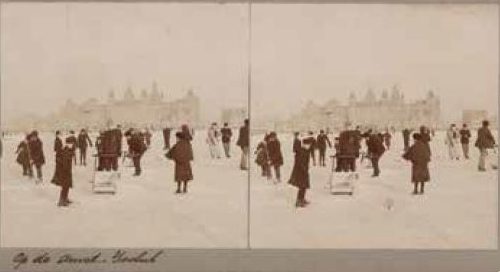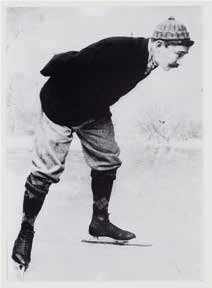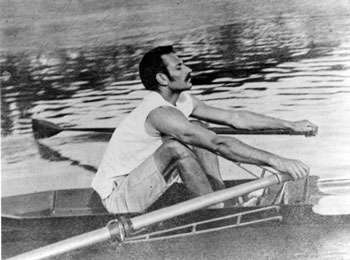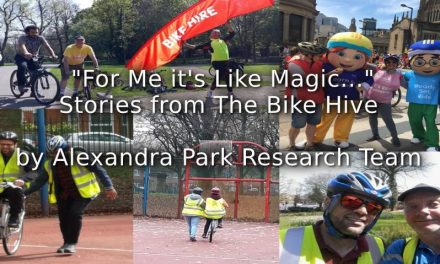To read the first part of this series – click HERE
1880 – The Oldest Photographs of Skating on the Ice
Below is just one of the marvellous section of the image database of Amsterdam City Archives contains thousands of stereo photos taken in the 19th century. A stereo photo consists of two shots taken from slightly different vantage points.
-
Stereo photo of skaters on the AIJC’s grounds, with the Rijksmuseum in the background.
Unknown photographer, c. 1885, Amsterdam City Archives
This imitates the principle of eyesight: our eyes are also close together when they look at an object. The brain combines these two different images into a three-dimensional, integrated whole. To produce the same effect when viewing a stereo photo, special glasses are used – a distant precursor of those used to watch 3D films today. A number of stereo photos show people skating on the ice, the oldest of which was made in the Vondel Park around
1880. Others were made at the ice rink behind the Rijksmuseum, just after the museum opened. Some years later,
a refreshment stand on the ice of the Keizersgracht was photographed using this technique. The special glasses suddenly bring this 19th-century sport to life in three dimensions. The only thing missing is film images, but no such recordings were made in that era. Still, thanks to some remarkable series of photographs dating from around 1890, we are nonetheless able to produce moving pictures of skaters.
Skating strokes in the picture
In 1888 and 1889 a number of skaters were photographed behind the Rijksmuseum using an ingenious technique.
Wires were stretched across the ice and attached to a row of cameras. As each wire broke, the camera connected to it
took a picture. The resulting series of four or eight photos taken in quick succession thus recorded an entire skating stroke. This ‘moment photography’ technique can be seen as a precursor of film. When the shots are projected in quick succession they produce a filmic effect of movement, similar to the effect that is so easy to produce in the digital age with a .gif file. It produces a moving photograph that enables us to see a skating stroke from 1889 as if it had been filmed. This only works on a computer screen, of course, not on paper.
Three such photograph series were made of people skating on the ice rink behind the Rijksmuseum around 1890. The images made it possible to study the technique of speedskating, which was a completely new phenomenon in
sport in the late 19th century. Moment photography thus stood at the cradle of present-day biomechanics. Past in motion The first series of photographs is in the book Wintertijd by Pim Mulier (1893). It shows Klaas Pander, a leading speed skater from Haarlem. The second series is taken from a book published in 1914 to mark the 50th anniversary of the Amsterdam Ice Skating Club. The latter is a kind of cartoon, made using moment photography and based on the 1892 book Skating by Charles Tebbutt. It shows the American skater Joe Donoghue, who became the first speedskating world champion – then still an unofficial title – in Amsterdam in 1891.
The 19th-century techniques of stereo and moment photography make it possible for us to see what skating looked like in Amsterdam over 125 years ago, almost as people saw it at the time: moving and in three dimensions. We have
literally set the past in motion.
1892 – The first official World Allround Speed Skating Championships
On 23–24 July 1892, the inaugural meeting was held of the International Skating Union (ISU). The timing – in the middle of summer – was so that the new body’s creation would coincide with the International Sports Exhibition, the first major sports exhibition in the Netherlands, which was taking place in Scheveningen at the time. For most of the 600,000 paying visitors to this event, it was their first introduction to sport – making it a perfect place to establish an international umbrella organisation for a sport.
-
Jaap Eden, winner of the first
official World Allround Speed
Skating Championships.
Unknown photographer, c. 1895 North Holland Archives
The first decision
One of the skating officials’ first decisions related to the rules for international combination events (over four distances). Het Algemeen Handelsblad wrote –
‘‘It was decided, to abandon the imperial units of length and henceforth to set all international races over four distances: 500, 1,500, 5,000, and 10,000 metres.’
The first World Allround Speed Skating Championships were held on the ice rink behind the Rijksmuseum on 13–14
January 1893, in accordance with the rules adopted by the new body. There had been world championships in the
years before this, but these had not been based on internationally-agreed rules. The winners were awarded a cup valued at 600 guilders and a wide orange sash. The Haarlem skater Jaap Eden won both the cup and the sash, which was celebrated jubilantly both in Amsterdam and in his own city. ‘The mood was one of great enthusiasm’, reported De Telegraaf, ‘ and Eden in particular was hailed with thunderous cheers’.
Elegant wigs
Het Nieuws van den Dag described the unprecedented festivities that took place in Haarlem:
‘Never before has your correspondent seen his fellow townspeople let their hair down to such an extent as when the news reached them this afternoon that our Jaap had also defeated his foreign rivals in the 500 metres, thus becoming world champion. Even those sporting the most elegant of wigs did a little leap in the air.’
De Telegraaf rightly concluded:
‘The Dutch Skating Federation and the Amsterdam Ice Skating Club can look back on this joyful event on the ice with satisfaction. The competition surpassed our expectations and ended in glorious success for Holland.’
That same month, Eden thanked his fans in a highly personal manner with an advertisement in the paper – something that today’s champions do in social media. In the paper Het Nieuws van den Dag of 26 January 1893, Eden placed the following message, which appeared among the obituaries:
‘Dear fellow countrymen! For the numerous, much appreciated, warm expressions of praise and sympathy that reached me in the past few days, I wish to express my sincerest gratitude.
With kind regards, JAAP EDEN. Haarlem, Jan. 1893.’
In publishing this message, the skating champion was following the example of the Amsterdam oarsman Janus Ooms, who had also published notices thanking his supporters for their numerous tributes in recent years.
- Janus Ooms
Precisely 125 years later, the World Allround Speed Skating Championships are still a combination event with the distances 500, 1,500, 5,000, and 10,000 metres – just as laid down in Scheveningen in 1892. This event is therefore the oldest world championship that is held in accordance with the original rules! It would therefore be fitting for the 2018 winners to place an advertisement saying:
‘Dear fellow skaters! For the numerous, much appreciated, warm expressions of praise and sympathy that reached us in the past few days, we wish to express our sincerest gratitude.
With kind regards, (Name of the Champion)
Article © Jurryt van de Vooren
To read Part 3 Click HERE
Reproduced by kind permission of the author – see https://t.co/e3QJkjZRjK








